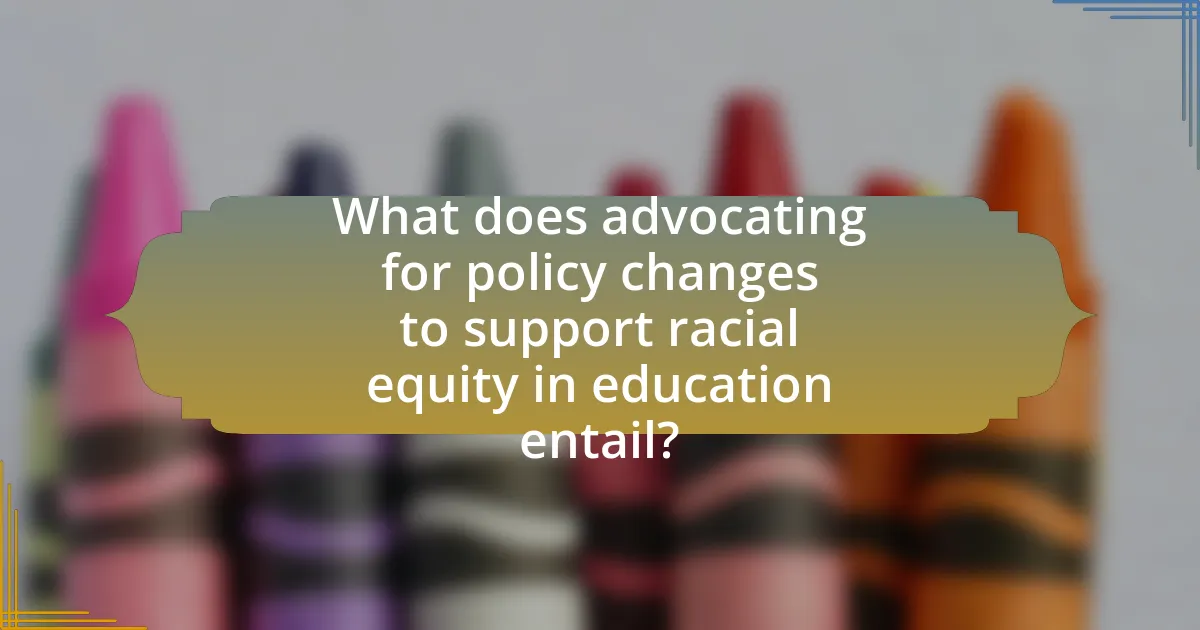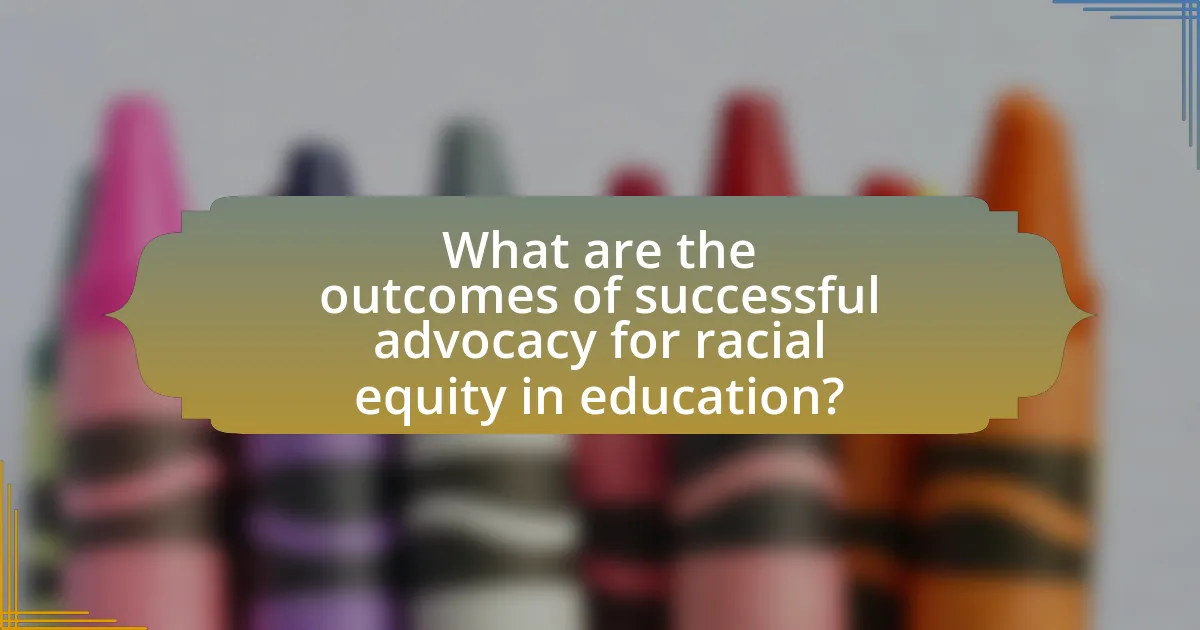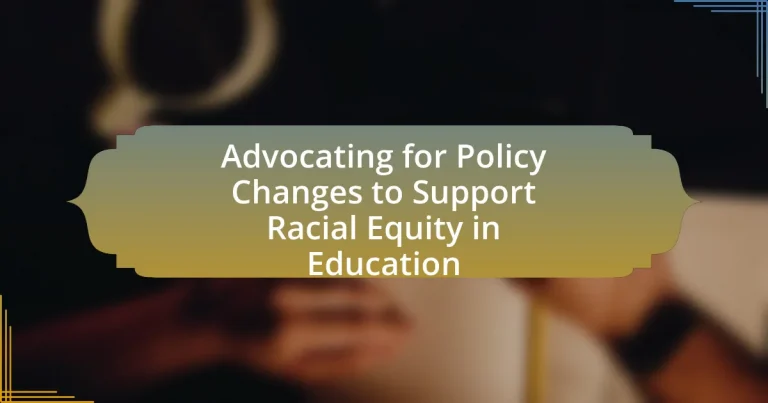The article focuses on advocating for policy changes to support racial equity in education, emphasizing the need for legislative and institutional reforms to eliminate disparities in educational access and outcomes for racially marginalized groups. It outlines the importance of racial equity in education, historical contexts of inequities, and the impact of racial disparities on student outcomes. Key policies requiring change, such as funding formulas and disciplinary practices, are discussed, along with strategies for advocacy, including grassroots mobilization and data-driven approaches. The article also highlights the roles of various stakeholders, including educators and community organizations, in promoting these necessary changes to foster an equitable educational environment.

What does advocating for policy changes to support racial equity in education entail?
Advocating for policy changes to support racial equity in education entails actively promoting legislative and institutional reforms aimed at eliminating disparities in educational access and outcomes for racially marginalized groups. This advocacy involves identifying systemic barriers, such as funding inequities and discriminatory practices, and proposing specific policy solutions, like equitable funding formulas and inclusive curricula. Evidence from studies, such as the 2018 report by the National Center for Education Statistics, shows that schools serving predominantly students of color often receive significantly less funding than those serving predominantly white students, highlighting the need for targeted policy interventions.
Why is racial equity in education important?
Racial equity in education is important because it ensures that all students, regardless of their racial or ethnic background, have equal access to quality educational opportunities. This equity is crucial for closing achievement gaps; for instance, research from the National Center for Education Statistics shows that students of color often face systemic barriers that hinder their academic performance and access to advanced coursework. By promoting racial equity, educational institutions can foster an inclusive environment that supports diverse learning needs, ultimately leading to improved outcomes for all students.
What are the historical contexts of racial inequities in education?
Racial inequities in education have historical contexts rooted in systemic discrimination and segregation. The establishment of racially segregated schools in the United States, particularly following the Plessy v. Ferguson decision in 1896, legitimized the “separate but equal” doctrine, which led to significant disparities in funding, resources, and educational opportunities for Black students compared to their white counterparts. For instance, in the early 20th century, Black schools received only a fraction of the funding allocated to white schools, resulting in overcrowded classrooms and inadequate facilities. The Civil Rights Movement of the 1960s, culminating in the Brown v. Board of Education decision in 1954, aimed to dismantle these inequities by declaring segregation in public schools unconstitutional. However, despite legal advancements, many schools remain racially and economically segregated due to factors such as housing policies and local funding mechanisms, perpetuating the cycle of inequity.
How do racial disparities impact student outcomes?
Racial disparities significantly impact student outcomes by contributing to unequal access to educational resources, which affects academic performance and achievement. For instance, students from marginalized racial backgrounds often attend underfunded schools with fewer qualified teachers and limited access to advanced coursework, leading to lower graduation rates and standardized test scores. According to the National Center for Education Statistics, schools serving predominantly Black and Hispanic students receive about $23 billion less in funding than those serving predominantly white students, exacerbating these disparities. This inequity in funding and resources directly correlates with poorer educational outcomes for students of color, highlighting the urgent need for policy changes to address these systemic issues.
What are the key policies that need to be changed?
Key policies that need to be changed to support racial equity in education include funding formulas that disproportionately disadvantage schools in low-income areas, disciplinary policies that lead to higher suspension and expulsion rates for students of color, and curriculum standards that lack representation of diverse histories and cultures. Research indicates that equitable funding can improve educational outcomes; for instance, the Education Trust found that schools serving predominantly students of color receive $23 billion less in funding than those serving mostly white students. Additionally, the U.S. Department of Education reports that Black students are suspended and expelled at rates three times higher than their white peers, highlighting the need for reform in disciplinary practices. Lastly, a study by the National Education Association emphasizes the importance of inclusive curricula in fostering a sense of belonging and improving academic performance among marginalized groups.
Which existing policies contribute to racial inequity in education?
Existing policies that contribute to racial inequity in education include funding disparities, school discipline policies, and standardized testing practices. Funding disparities arise from reliance on local property taxes, which often results in schools in predominantly white neighborhoods receiving significantly more resources than those in communities of color. For example, a report by the Education Trust found that schools serving students of color receive about $23 billion less in funding than those serving predominantly white students. School discipline policies disproportionately affect students of color, with data showing that Black students are suspended and expelled at rates three times higher than their white peers, as reported by the U.S. Department of Education. Additionally, standardized testing practices often disadvantage students from marginalized backgrounds, as these assessments may not account for cultural differences or provide adequate support for English language learners, leading to lower performance and further inequities in educational opportunities.
How can policy changes address systemic barriers?
Policy changes can address systemic barriers by implementing equitable funding models that ensure all schools receive adequate resources regardless of their geographic or socioeconomic status. For instance, research from the Education Trust highlights that states with weighted funding formulas, which allocate more resources to schools serving higher populations of low-income students, have seen improvements in educational outcomes. Additionally, policy changes can mandate inclusive curricula that reflect diverse histories and perspectives, thereby fostering a more equitable learning environment. Evidence from the National Education Association indicates that such curricula can enhance student engagement and achievement, particularly among marginalized groups. By reforming disciplinary policies to reduce suspensions and expulsions, schools can also create a more supportive atmosphere that keeps students in the classroom, as shown by studies from the U.S. Department of Education, which found that restorative justice practices lead to lower rates of disciplinary actions and improved student relationships.
Who are the stakeholders involved in advocating for these changes?
The stakeholders involved in advocating for changes to support racial equity in education include educators, parents, community organizations, policymakers, and advocacy groups. Educators push for equitable teaching practices and curriculum reforms, while parents advocate for their children’s rights and access to quality education. Community organizations often mobilize grassroots efforts to raise awareness and influence policy. Policymakers are crucial as they create and implement legislation that can promote equity. Advocacy groups, such as the NAACP and the Education Trust, provide research, resources, and lobbying efforts to support these initiatives. These stakeholders collectively work to address systemic inequalities and promote inclusive educational policies.
What roles do educators play in advocating for policy changes?
Educators play a crucial role in advocating for policy changes by serving as informed voices for their students and communities. They leverage their firsthand experiences in the classroom to identify inequities and propose solutions that promote racial equity in education. For instance, educators can participate in policy discussions, collaborate with advocacy groups, and engage in grassroots movements to influence decision-makers. Research shows that teachers who actively engage in advocacy can lead to significant policy reforms, such as the implementation of culturally relevant curricula and equitable funding practices, which are essential for addressing systemic disparities in education.
How can parents and communities influence educational policies?
Parents and communities can influence educational policies by actively engaging in advocacy efforts, participating in school board meetings, and forming coalitions to voice their concerns and priorities. For instance, organized groups like the National Parent Teacher Association (PTA) have successfully lobbied for policy changes that promote equity in education, demonstrating the power of collective action. Research indicates that when parents are involved in decision-making processes, schools are more likely to adopt policies that reflect the needs of diverse communities, thereby enhancing racial equity in education.

What strategies can be employed to advocate for policy changes?
To advocate for policy changes, stakeholders can employ strategies such as grassroots mobilization, coalition building, and data-driven advocacy. Grassroots mobilization involves engaging community members to raise awareness and influence policymakers through organized campaigns. Coalition building brings together diverse groups to amplify voices and create a unified front, enhancing credibility and reach. Data-driven advocacy utilizes research and statistics to support claims, demonstrating the need for policy changes with concrete evidence, such as studies showing disparities in educational outcomes among racial groups. These strategies have been effective in various movements, including the civil rights movement, where collective action and empirical evidence played crucial roles in achieving legislative reforms.
How can grassroots movements impact educational policy?
Grassroots movements can significantly impact educational policy by mobilizing community members to advocate for changes that promote equity and inclusion. These movements often raise awareness about systemic issues in education, such as funding disparities and discriminatory practices, which can lead to policy reforms. For instance, the Black Lives Matter at School movement has successfully influenced school districts to adopt anti-racist curricula and implement restorative justice practices, demonstrating the power of collective action in shaping educational policies. Additionally, grassroots organizations often engage in lobbying efforts, public demonstrations, and coalition-building, which can pressure policymakers to prioritize racial equity in education.
What are effective methods for mobilizing community support?
Effective methods for mobilizing community support include organizing community meetings, leveraging social media campaigns, and forming partnerships with local organizations. Community meetings facilitate direct engagement, allowing individuals to voice concerns and share ideas, which fosters a sense of ownership and commitment. Social media campaigns can reach a broader audience quickly, raising awareness and encouraging participation through shares and likes. Partnerships with local organizations enhance credibility and provide additional resources, amplifying the message and mobilizing more supporters. Research shows that grassroots movements that utilize these methods can significantly increase community involvement and advocacy efforts, as evidenced by successful campaigns in various social justice initiatives.
How can social media be leveraged for advocacy?
Social media can be leveraged for advocacy by creating awareness, mobilizing supporters, and facilitating dialogue around issues. Platforms like Twitter and Facebook allow advocates to share information quickly, reaching a broad audience and engaging them in discussions about racial equity in education. For instance, campaigns such as #BlackLivesMatter have effectively utilized social media to highlight systemic injustices and rally support for policy changes. Research indicates that social media campaigns can increase public engagement and influence policymakers, as seen in the 2018 student-led March for Our Lives movement, which gained significant traction through online platforms.
What role do data and research play in advocacy efforts?
Data and research are critical in advocacy efforts as they provide evidence-based support for policy changes. In the context of advocating for racial equity in education, data can highlight disparities in educational outcomes among different racial groups, demonstrating the need for targeted interventions. For instance, studies show that Black and Hispanic students often face significant achievement gaps compared to their white peers, with the National Assessment of Educational Progress reporting that in 2019, only 18% of Black eighth graders were proficient in math, compared to 45% of white eighth graders. This data empowers advocates to make informed arguments for policy reforms aimed at addressing these inequities. Furthermore, research can identify effective strategies and programs that have successfully improved educational equity, providing a roadmap for policymakers. Thus, data and research not only substantiate advocacy claims but also guide the development of effective solutions.
How can data be used to highlight inequities in education?
Data can be used to highlight inequities in education by analyzing metrics such as student achievement, funding disparities, and access to resources. For instance, standardized test scores can reveal performance gaps between different racial and socioeconomic groups, indicating systemic inequities. Additionally, data on school funding shows that schools in predominantly minority neighborhoods often receive less financial support compared to those in affluent areas, which can lead to disparities in educational quality. Research from the National Center for Education Statistics indicates that schools serving high percentages of students from low-income families tend to have fewer experienced teachers and less access to advanced coursework, further underscoring the inequities present in the education system.
What types of research are most persuasive in policy discussions?
Empirical research, particularly studies that utilize randomized controlled trials (RCTs) and longitudinal data, are the most persuasive in policy discussions. RCTs provide robust evidence of causal relationships by comparing outcomes between treatment and control groups, which is critical for demonstrating the effectiveness of educational interventions aimed at promoting racial equity. For instance, a study by the Institute of Education Sciences found that RCTs in education can yield insights that significantly influence policy decisions. Additionally, longitudinal studies track changes over time, offering insights into the long-term impacts of policies on racial equity in education. These types of research are favored because they provide clear, quantifiable evidence that policymakers can use to justify changes in educational practices and funding allocations.
What are the challenges faced in advocating for policy changes?
Advocating for policy changes faces several challenges, including political resistance, lack of funding, and insufficient public awareness. Political resistance often stems from entrenched interests that oppose changes to the status quo, making it difficult to gain legislative support. Lack of funding can hinder advocacy efforts, as resources are necessary for outreach, research, and mobilization. Insufficient public awareness about the issues at stake can lead to low engagement and support for proposed changes, further complicating the advocacy process. These challenges are evident in various case studies, such as the struggle for equitable funding in education, where advocacy groups have encountered significant obstacles despite clear evidence of disparities.
What resistance do advocates encounter from policymakers?
Advocates encounter significant resistance from policymakers primarily due to entrenched political interests and differing priorities. Policymakers may prioritize budget constraints, leading to reluctance in allocating funds for initiatives aimed at racial equity in education. Additionally, some policymakers may hold ideological beliefs that conflict with the goals of advocates, resulting in opposition to proposed changes. For instance, research indicates that policymakers often face pressure from constituents who may not support equity initiatives, further complicating the advocacy efforts. This resistance can manifest in legislative gridlock or the dilution of proposed policies, hindering progress toward achieving racial equity in education.
How can advocates overcome funding and resource limitations?
Advocates can overcome funding and resource limitations by leveraging partnerships with local organizations and seeking grants specifically aimed at educational equity. Collaborating with community groups can provide access to shared resources and expertise, while targeted grants from foundations focused on racial equity in education can supplement financial needs. For instance, the W.K. Kellogg Foundation has funded initiatives that promote racial equity in education, demonstrating the availability of financial support for such causes. Additionally, advocates can engage in grassroots fundraising efforts, mobilizing community support to generate funds for their initiatives.

What are the outcomes of successful advocacy for racial equity in education?
Successful advocacy for racial equity in education leads to improved educational outcomes for marginalized students. This includes increased access to quality resources, equitable funding for schools, and the implementation of culturally relevant curricula. Research indicates that schools with equitable practices see higher graduation rates and better academic performance among students of color. For instance, a study by the Education Trust found that equitable funding can close achievement gaps, demonstrating that targeted advocacy efforts can result in significant improvements in educational equity.
How do policy changes improve educational outcomes for marginalized students?
Policy changes improve educational outcomes for marginalized students by addressing systemic inequities and providing targeted resources. For instance, implementing policies that allocate additional funding to schools in low-income areas has been shown to enhance access to quality teachers and learning materials, which directly correlates with improved student performance. Research from the National Bureau of Economic Research indicates that increased funding in disadvantaged schools leads to higher graduation rates and better standardized test scores. Additionally, policies that promote inclusive curricula and culturally relevant teaching practices foster a more engaging learning environment, which has been linked to increased student motivation and achievement among marginalized groups.
What evidence supports the effectiveness of these policy changes?
Evidence supporting the effectiveness of policy changes advocating for racial equity in education includes improved student outcomes and increased access to resources. For instance, studies have shown that implementing equitable funding models leads to a significant rise in graduation rates among marginalized groups; a report by the Education Trust indicates that schools with equitable funding saw a 10% increase in graduation rates over five years. Additionally, research from the National Education Association highlights that policies promoting inclusive curricula enhance student engagement and performance, particularly for students of color, demonstrating a direct correlation between policy changes and educational equity.
How do successful advocacy efforts create long-term systemic change?
Successful advocacy efforts create long-term systemic change by mobilizing communities, influencing policy, and fostering accountability among decision-makers. These efforts often involve grassroots organizing, which empowers individuals to voice their concerns and demands, leading to increased public awareness and support for specific issues. For instance, the Civil Rights Movement in the United States successfully advocated for educational reforms that dismantled segregation, resulting in landmark legislation such as the Elementary and Secondary Education Act of 1965. This act not only provided federal funding to schools but also aimed to close the achievement gap, demonstrating how advocacy can lead to enduring policy changes that promote racial equity in education. Furthermore, sustained advocacy efforts often establish coalitions that maintain pressure on policymakers, ensuring that reforms are implemented effectively and adapted over time to meet evolving community needs.
What best practices can advocates follow to ensure success?
Advocates can ensure success by employing strategic coalition-building, effective communication, and data-driven advocacy. Coalition-building allows advocates to unite diverse stakeholders, enhancing credibility and amplifying their message. Effective communication involves tailoring messages to resonate with different audiences, ensuring clarity and engagement. Data-driven advocacy relies on empirical evidence to support claims, making arguments more persuasive; for instance, studies show that schools with equitable funding models improve student outcomes, highlighting the importance of financial equity in education.
What strategies have proven effective in past advocacy campaigns?
Effective strategies in past advocacy campaigns for racial equity in education include grassroots mobilization, coalition building, and data-driven storytelling. Grassroots mobilization engages community members directly, fostering a sense of ownership and urgency, as seen in the Civil Rights Movement, where local activists organized protests and voter registration drives. Coalition building among diverse stakeholders, such as educators, parents, and civil rights organizations, amplifies voices and resources, exemplified by the collaboration in the “Black Lives Matter at School” movement, which united various groups to advocate for policy changes. Data-driven storytelling utilizes statistics and personal narratives to highlight disparities and drive home the need for change, as demonstrated by the “Education Trust,” which effectively used data to advocate for equitable funding and resources in schools serving marginalized communities. These strategies have consistently shown effectiveness in mobilizing support and achieving policy changes in the realm of racial equity in education.
How can advocates maintain momentum and engagement over time?
Advocates can maintain momentum and engagement over time by consistently communicating the importance of their cause and actively involving stakeholders in the advocacy process. Regular updates through newsletters, social media, and community meetings keep the issue at the forefront of public consciousness. Engaging stakeholders, such as educators, parents, and community leaders, fosters a sense of ownership and commitment to the cause. Research indicates that sustained engagement strategies, such as organizing events and providing educational resources, can lead to increased participation and support, as seen in successful advocacy campaigns for educational reforms.
What resources are available for advocates seeking to promote racial equity in education?
Advocates seeking to promote racial equity in education can access a variety of resources, including organizations, toolkits, and research reports. Notable organizations such as the NAACP, Education Trust, and the National Equity Project provide frameworks and strategies for advocacy. Toolkits like the “Racial Equity Toolkit” from the Government Alliance on Race and Equity offer practical steps for implementing equity initiatives. Research reports, such as “The State of Racial Equity in Education” by the Education Trust, provide data and analysis that support advocacy efforts. These resources collectively equip advocates with the necessary knowledge and tools to effect policy changes that promote racial equity in educational settings.
Which organizations provide support and guidance for advocacy efforts?
Organizations that provide support and guidance for advocacy efforts include the American Civil Liberties Union (ACLU), the NAACP Legal Defense and Educational Fund, and the Education Trust. The ACLU focuses on protecting civil rights and liberties, offering resources for advocacy campaigns. The NAACP Legal Defense and Educational Fund specializes in racial justice and education equity, providing legal support and policy guidance. The Education Trust works to close opportunity gaps for students of color and low-income students, offering research and advocacy tools to influence policy changes. These organizations are instrumental in shaping effective advocacy strategies and mobilizing community efforts for racial equity in education.
How can advocates access training and educational materials?
Advocates can access training and educational materials through various online platforms, educational institutions, and nonprofit organizations dedicated to racial equity in education. Many organizations, such as the National Education Association and the American Civil Liberties Union, provide free resources, webinars, and workshops specifically designed for advocates. Additionally, universities often offer courses and materials related to advocacy and policy changes in education, which can be accessed through their websites or continuing education programs. These resources are essential for equipping advocates with the knowledge and skills necessary to effectively promote racial equity in educational policies.


